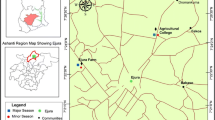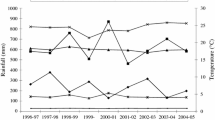Abstract
Aiming to investigate the residual, direct and interaction effect of nutrient management on growth, yield, quality, nutrient uptake, monetary efficiency of fodder maize and soil nutrient balance under grain amaranth–fodder maize sequence, a 2 year field experiment was carried out in “Deep Black Soil.” Seven treatments were applied to grain amaranth and subsequently each plot was equally divided into two parts for summer fodder maize. There was a beneficial residual effect of nutrient sources on fodder maize and significantly maximum growth, yield, quality attributes, nutrient uptake, amaranth equivalent yield and benfit-cost ratio (BCR) were noted under treatment farm yard manure (FYM) 2.5 t/ha + 100% recommended dose of fertilizer (T7) being at par with vermicompost 2.5 t/ha + 75% recommended dose of fertilizer (T6) and bio compost 2.5 t/ha + 75% recommended dose of fertilizer (T4). The treatments with 100% recommended dose of fertilizer (F2) showed noticeably higher values of all parameters when recommended dose of fertilizer levels were directly applied to summer fodder maize. The results of treatment combination T7F2 (application of farm yard manure 2.5 t/ha + 100% recommended dose of fertilizer coupled with 100% recommended dose of fertilizer treatment) showed significantly higher values of various growth and yield characters of the succeeding summer fodder maize crop which remained at par with treatment combinations T6F2 (Application of vermicompost 2.5 t/ha + 75% recommended dose of fertilizer coupled with 100% recommended dose of fertilizer treatment) and T4F2 (application of bio compost 2.5 t/ha + 75% recommended dose of fertilizer coupled with 100% recommended dose of fertilizer treatment) when pooled. Soil nutrient balance was positively improved due to the cumulative effect of bio compost 2.5 t/ha + 75% recommended dose of fertilizer coupled with 100% recommended dose of fertilizer treatment (T4F2) in sequence. Therefore, to achieve increased productivity, cost effectiveness and soil health, bio compost 2.5 t/ha + 75% recommended dose of fertilizer should be applied to the rabi grain amaranth crop and 100% recommended dose of fertilizer should be applied to the summer fodder maize crop.


Similar content being viewed by others
References
Ahmad S, Khan AA, Kamran M, Ahmad I, Ali S (2018) Response of maize cultivars to various nitrogen levels. Eur J Exp Bio 08(01):1–4. https://doi.org/10.21767/2248-9215.100043
Amanullah and Inamullah (2016) Residual phosphorus and zinc influence wheat productivity under rice- wheat crop** system. Springer plus 5:255. https://doi.org/10.1186/s40064-016-1907-0
Black CA (1986) Methods of Soil Analysis Part 1 and 2. American Society of Agronomy, Inc.; USA.
Chaudhary JD, Pavaya RP, Malav JK, Goradara D, Chaudhary N, Kuniya NK, Vina AL, Patel IM, Jat JR (2018) Effect of nitrogen and potassium on yield, nutrient content and uptake by forage sorghum [Sorghum bicolor (L.) Moench] on loamy sand. Indian J chem stud, 6 (2): 761–765. https://www.researchgate.net/publication/323725704
Dixit AK, Kumar S, Rai AK, Kumar TK (2015) System productivity, profitability, nutrient uptake and soil health under tillage, nutrient and weed management in rainfed chickpea- fodder sorghum crop** system. Indian J Agron 60(2):205–211
Gaur CA (1990) Soil chemical analysis. Prentice-Hall of India Pvt. Ltd., New Delhi
Hazra CR (2014) Feed and forage resources for sustainable livestock development. Rang Manage Agrofor 35(1):1–14
Hidayatullah A, Jan A, Shah Z (2013) Residual effect of organic nitrogen sources applied to rice on the subsequent wheat crop. Int J Agron Plant Product, 4: 620–631. https://www.researchgate.net/publication/262183625
Jackson ML (1973) Soil chemical analysis. Prentice Hall of India Private Limited, New Delhi, p 498
Jadav VM, Patel PM, Chaudhari JB, Patel JM, Chaudhari PP (2018) Effect of integrated nutrient management on growth and yield of rabi forage maize (Zea mays L.). Int J Chem Stud, 6 (1): 2160–2163. https://www.researchgate.net/publication/344283578
Jangir R, Thanki JD, Patil KB, Saini LK (2021) Residual and direct effect of integrated nutrient management on growth, yield, monetary efficiency, nutrient uptake of cowpea and soil properties under grain amaranth (Amaranthus hypochondriacus L.)-cowpea [Vigna unguiculata (L.) Walp] crop** sequence in Inceptisols of Western India. J Plant Nutr. https://doi.org/10.1080/01904167.2021.1927085
Jat RS, Ahlawat IPS (2006) Direct and residual effect of vermicompost, biofertilizers and phosphorus on soil nutrient dynamics and productivity of chickpea- fodder maize sequence. J Sustain Agric 28(1):41–54. https://doi.org/10.1300/J064v28n01_05
Jat NK, Kumar A, Meena SR, Rana DS, Meena BP, Rana KS (2012) Influence of integrated nutrient management on the productivity, quality and soil health of maize (Zea mays)-wheat (Triticum aestivum) crop** system. Indian J Agron 57(4):327–332
Joshi MP, Virdia HM, Patel HA (2020) Effect of nutrient practices on performance and quality of rabi green gram (Vigna radiata L.)-pearl millet (Pennisetum glaucum L.) crop** sequence. J Pharmacogn Phytochem 9(5):2060–2064
Kalal PH, Viradia HM (2023) Effect of integrated nutrient management on growth, yield and quality of summer green gram (Vigna radiata L.): kharif finger millet (Eleusine coracana L.) crop** sequence under South Gujarat condition. Pharma Innov J, 12 (10): 1093–1096. https://www.researchgate.net/publication/374873428
Kanduri AB, Patil PV, Mogale PS (2016) Green fodder yield and nutrient composition of african tall fodder maize (Zea mays L.) with various nitrogen-phosphorus levels. Int J Adv Eng Manage Sci 2(5):279–281
Kumar R, Singh M, Meena BS, Kumar S, Yadav MR, Parihar CM, Meena RH, Kumar U (2017) Quality characteristics and nutrient yield of fodder maize (Zea mays L.) as influenced by seeding density and nutrient levels in Indo-Gangetic plains. Indian J Agric Sci, 87 (9): 1203–1208. https://www.researchgate.net/publication/318982810
Mahdi SS, Hadan B, Bhat RA, Aziz MA, Singh L (2011) Effect of nitrogen, zinc and seed rate on growth dynamics and yield of fodder maize under temperate conditions. Plant Archives, 11 (2): 965–971. https://www.cabidigitallibrary.org/doi/full/https://doi.org/10.5555/20123402163
Mansuri RN (2016) Effect of integrated nutrient management in rice- chickpea crop** sequence under south Gujarat condition. Ph.D. thesis submitted to the Navsari Agricultural University, Navsari (Gujarat).
Motiramani DP, Wankhede RD (1970) Effect of different row ratios on yield and quality of oat (Avena sativa L.) and Lucerne (Medicago sativa L.) intercrop**. Lab Man Agric Chem 8:126–129
Nambiar K, Abrol IP (1989) Long term fertilizer experiments in India—an overview. Fertilizer News, 34 (4): 11–20. https://www.cabidigitallibrary.org/doi/full/https://doi.org/10.5555/19891938148
Panse VG, Sukhatme PV (1967) Statistical methods for agricultural workers. ICAR, New Delhi, pp 187–197
Patel HA, Thanki JD (2022) Productivity, profitability and nutrient status of soil as influenced by integrated nutrient management in chickpea-fodder maize crop** sequence. Legum Res 45(5):620–625. https://doi.org/10.18805/LR-4792
Patel KM, Patel DM, Gelot DG, Patel IM (2018) Effect of integrated nutrient management on green forage yield, quality and nutrient uptake of fodder sorghum. Int J Chem Stud 6(1):173–176
Piper CS (1966) Soil and Plant Analysis. Acedemic press, Inter Science Publishing Corporation. Inc. New York, pp. 47–77.
Sadasivam S, Manickam A (2005) Biochemical methods. New Age International Limited Publishers, Newyork, pp 34–35
Srivastava, R. (2011). National quality of some cultivated and wild species of Amaranthus. Int J Pharmaceut Sci Res, 2 (12): 90–95. https://www.researchgate.net/publication/267960456
Subbiah BV, Asija GL (1956) A rapid procedure for the estimation of available nitrogen in soil. Curr Sci 25:259–260
Tayade MS, Bawkar SO, Kale VS, Deshmukh UB (2012) Integrated nutrient management in Amaranthus. As J Hortic 7(2):291–293
Funding
The authors did not receive support from any organization for the submitted work.
Author information
Authors and Affiliations
Corresponding author
Ethics declarations
Conflict of interest
The authors have no relevant financial or non-financial interests to disclose.
Additional information
Communicated by Márton Jolánkai.
Rights and permissions
Springer Nature or its licensor (e.g. a society or other partner) holds exclusive rights to this article under a publishing agreement with the author(s) or other rightsholder(s); author self-archiving of the accepted manuscript version of this article is solely governed by the terms of such publishing agreement and applicable law.
About this article
Cite this article
Patel, R., Pankhania, R.M., Bartwal, D. et al. Residual, direct and interaction effect of nutrient management on growth, yield, quality, and economics of fodder maize and soil nutrient balance under grain amaranth (Amaranthus hypochondriacus L.)– fodder maize [Zea mays (L.)] sequence in Inceptisols of Western India. CEREAL RESEARCH COMMUNICATIONS (2024). https://doi.org/10.1007/s42976-024-00535-1
Received:
Accepted:
Published:
DOI: https://doi.org/10.1007/s42976-024-00535-1




